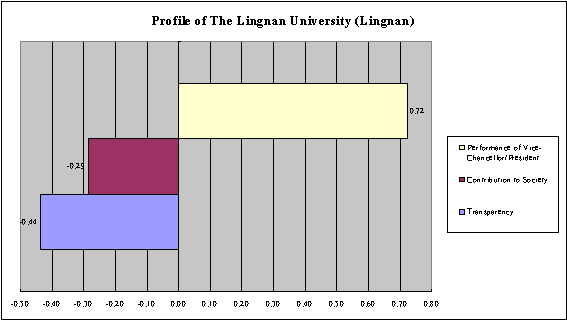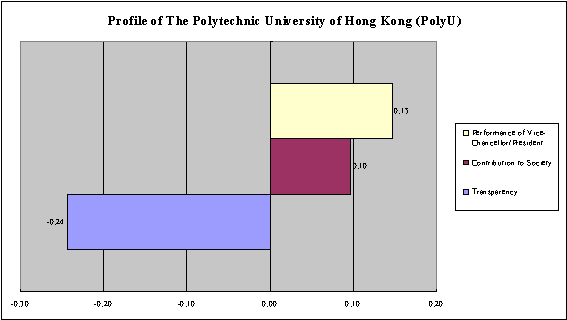Summary of FindingsBack
The first part of the survey was to study the general public's perception of the local universities, namely, The Chinese University of Hong Kong (CUHK), The City University of Hong Kong (CityU), The Hong Kong Baptist University (HKBU), The Hong Kong Institute of Education (HKIEd), The Hong Kong University of Science and Technology (HKUST), The Lingnan University (Lingnan), The Polytechnic University of Hong Kong (PolyU) and The University of Hong Kong (HKU), order rotated in different questionnaires. By means of a rating scale from 0-10, with 0 representing the worst, 10 representing the best and 5 being half-half, these universities were assessed one by one with regard to their overall performance plus three core attributes selected by the researcher and the client. | |||||||||||||||||||||||||||||||||||||||||||||||||||||||||||||||||||||||||||||
In order to eliminate possible bias due to ordering, the sequence of rating the eight universities was randomly rotated across all rating questions. | |||||||||||||||||||||||||||||||||||||||||||||||||||||||||||||||||||||||||||||
A. Overall Performance | |||||||||||||||||||||||||||||||||||||||||||||||||||||||||||||||||||||||||||||
First of all, all respondents were asked to evaluate each of these local universities based on their perception of its overall performance using a scale of 0-10, with 0 representing the worst, 10 representing the best and 5 being half-half. Respondents were suggested to take into account the university's local and international reputation, facilities, campus environment, qualification of its teaching staff, academic research performance, conduct and quality of its students, its learning atmosphere, as well as the diversification and degree of recognition for its courses. Survey result shows that, in terms of public perception, HKU received the highest mean score of 7.87 as rated by 728 respondents, CUHK came second with an average score of 7.53 rated by 725 respondents, whereas HKUST ranked third with a mean score of 7.16 rated by 685 respondents (Table 1). | |||||||||||||||||||||||||||||||||||||||||||||||||||||||||||||||||||||||||||||
| Table 1 - Overall Performance | |||||||||||||||||||||||||||||||||||||||||||||||||||||||||||||||||||||||||||||
| |||||||||||||||||||||||||||||||||||||||||||||||||||||||||||||||||||||||||||||
B. Transparency in Dealing with Internal and External Parties | |||||||||||||||||||||||||||||||||||||||||||||||||||||||||||||||||||||||||||||
As regards the perceived transparency of each university when carrying out new policies and reforms, taking into consideration its performance in consulting its students and staff, releasing information to the mass media, as well as explaining itself to the public and collecting public opinions, HKU again received the highest rating with a mean score of 6.64 rated by 546 respondents, whereas CUHK ranked second with an average score of 6.60 from 546 respondents, which comprised the first tier in terms of perceived transparency. The third and fourth ranks, which formed the next tier, fell to HKUST (6.29) and PolyU (6.17) respectively (Table 2). | |||||||||||||||||||||||||||||||||||||||||||||||||||||||||||||||||||||||||||||
| Table 2 - Transparency | |||||||||||||||||||||||||||||||||||||||||||||||||||||||||||||||||||||||||||||
| |||||||||||||||||||||||||||||||||||||||||||||||||||||||||||||||||||||||||||||
C. Contribution to Society made by Teaching Staff | |||||||||||||||||||||||||||||||||||||||||||||||||||||||||||||||||||||||||||||
As on the perceived contribution made to society by each university's teaching staff, taking into consideration their academic research performance, efforts in promoting their university's image and upgrading its international ranking, participation in community services, as well as their response and commitment to the needs of society, HKU again received the highest mean score of 7.28 rated by 596 respondents, followed closely by CUHK at 7.17 from 599 raters and then HKUST at 6.90 rated by 565 respondents (Table 3). | |||||||||||||||||||||||||||||||||||||||||||||||||||||||||||||||||||||||||||||
| Table 3 - Contribution to Society | |||||||||||||||||||||||||||||||||||||||||||||||||||||||||||||||||||||||||||||
| |||||||||||||||||||||||||||||||||||||||||||||||||||||||||||||||||||||||||||||
D. Overall Performance of Vice-Chancellor/President | |||||||||||||||||||||||||||||||||||||||||||||||||||||||||||||||||||||||||||||
The last question rated in this part of the survey was the perceived overall performance of the Vice-Chancellor/President of each university, taking into consideration one's local and international reputation, approachability, leadership, vision, social credibility and public relations. It is noteworthy that the recognition rates for all current Vice-Chancellors/ Presidents rated were below 50% (ranging from 37% to 49%), lower than all other attributes described before. In this aspect, Professor Paul C.W. Chu of HKUST received the highest average score of 7.26 rated by 495 respondents, and Professor Arthur K.C. Li of CUHK came second, with a mean score of 7.09 rated by 503 respondents. The next tier was formed by the Vice-Chancellors/Presidents of HKU, PolyU, Lingnan, HKBU and CityU (in descending order), as their average scores fell within a narrow range from 6.67 to 6.31. Professor Ruth Hayhoe of HKIEd received a mean score of 5.94 as well as the lowest recognition rate (Table 4). | |||||||||||||||||||||||||||||||||||||||||||||||||||||||||||||||||||||||||||||
| Table 4 - Overall Performance of Vice-Chancellor/President | |||||||||||||||||||||||||||||||||||||||||||||||||||||||||||||||||||||||||||||
| |||||||||||||||||||||||||||||||||||||||||||||||||||||||||||||||||||||||||||||
E. Relative Strengths and Weaknesses | |||||||||||||||||||||||||||||||||||||||||||||||||||||||||||||||||||||||||||||
As a collective analysis, the average scores attained by each university regarding three of the above attributes (excluding the overall performance rating of the universities) were used to produce a relative strength-and-weakness profile. | |||||||||||||||||||||||||||||||||||||||||||||||||||||||||||||||||||||||||||||
As shown from Charts 1 to 8 (in alphabetical order of universities), all attributes with a positive value (presented on the right side of the chart) represent the relative strengths of each university in terms of the three attributes measured. Conversely, negative attributes (on the left of the chart) refer to their relative weaknesses. And the value next to each bar denotes the net difference between the average score of that particular attribute and the overall average of the three attributes obtained by each university. However, since the list of attributes measured in this survey is far from comprehensive (only three, even after including the performance of their Vice-Chancellors/Presidents into the analysis), the profiles shown here would not be able to reflect the full picture. They are included here just to demonstrate one approach to make sense of the data collected, using a framework developed in last year's survey. | |||||||||||||||||||||||||||||||||||||||||||||||||||||||||||||||||||||||||||||
As a general observation, among the three attributes measured, transparency is a negative asset for all universities. HKU is unique in that the contribution made by its staff stands out as its only strength among the three attributes. For Lingnan and CityU, the performance of their Presidents stands out to be their only strength among the three attributes. For all universities, there seems to be a mixture of strengths, with CUHK more on the contribution attribute, and others more on the performance of their Vice-Chancellors/Presidents. | |||||||||||||||||||||||||||||||||||||||||||||||||||||||||||||||||||||||||||||
| Chart1 | |||||||||||||||||||||||||||||||||||||||||||||||||||||||||||||||||||||||||||||

| |||||||||||||||||||||||||||||||||||||||||||||||||||||||||||||||||||||||||||||
| Chart2 | |||||||||||||||||||||||||||||||||||||||||||||||||||||||||||||||||||||||||||||

| |||||||||||||||||||||||||||||||||||||||||||||||||||||||||||||||||||||||||||||
| Chart3 | |||||||||||||||||||||||||||||||||||||||||||||||||||||||||||||||||||||||||||||

| |||||||||||||||||||||||||||||||||||||||||||||||||||||||||||||||||||||||||||||
| Chart4 | |||||||||||||||||||||||||||||||||||||||||||||||||||||||||||||||||||||||||||||

| |||||||||||||||||||||||||||||||||||||||||||||||||||||||||||||||||||||||||||||
| Chart5 | |||||||||||||||||||||||||||||||||||||||||||||||||||||||||||||||||||||||||||||

| |||||||||||||||||||||||||||||||||||||||||||||||||||||||||||||||||||||||||||||
| Chart6 | |||||||||||||||||||||||||||||||||||||||||||||||||||||||||||||||||||||||||||||

| |||||||||||||||||||||||||||||||||||||||||||||||||||||||||||||||||||||||||||||
| Chart7 | |||||||||||||||||||||||||||||||||||||||||||||||||||||||||||||||||||||||||||||

| |||||||||||||||||||||||||||||||||||||||||||||||||||||||||||||||||||||||||||||
| Chart8 | |||||||||||||||||||||||||||||||||||||||||||||||||||||||||||||||||||||||||||||

| |||||||||||||||||||||||||||||||||||||||||||||||||||||||||||||||||||||||||||||
F. Experience in Taking Courses in Institutions of Continuing Education | |||||||||||||||||||||||||||||||||||||||||||||||||||||||||||||||||||||||||||||
The second part of the survey investigated respondents' experience or interest in taking programmes offered by the local schools of continuing education. Results show that a total of 316 respondents (31% of the overall sample) had taken or considered taking these programmes, including all academic or leisure courses, sub-degree or higher diploma programmes, and courses offered on short-term or long-term basis. | |||||||||||||||||||||||||||||||||||||||||||||||||||||||||||||||||||||||||||||
As far as the academic and leisure courses are concerned, excluding sub-degree and higher diploma programmes, 14% had taken such courses, another 12% had thought of taking them, together giving a total of 26% (Table 5). | |||||||||||||||||||||||||||||||||||||||||||||||||||||||||||||||||||||||||||||
When it came to sub-degree programmes tailored for those not qualified to take on degree programmes, only 2% had taken them, while another 4% have considered taking them (Table 6). Apart from the fact that most respondents were not eligible for these programmes, the fact that these sub-degree programmes were newly launched by the local universities may have contributed to these low figures. | |||||||||||||||||||||||||||||||||||||||||||||||||||||||||||||||||||||||||||||
As on the high diploma programmes, 7% had taken them, while another 8% have considered taking them (Table 7). | |||||||||||||||||||||||||||||||||||||||||||||||||||||||||||||||||||||||||||||
| Table 5 - Experience in Taking Academic or Leisure Courses | |||||||||||||||||||||||||||||||||||||||||||||||||||||||||||||||||||||||||||||
| |||||||||||||||||||||||||||||||||||||||||||||||||||||||||||||||||||||||||||||
| Table 6 - Experience in Taking Sub-degree Programmes | |||||||||||||||||||||||||||||||||||||||||||||||||||||||||||||||||||||||||||||
| |||||||||||||||||||||||||||||||||||||||||||||||||||||||||||||||||||||||||||||
| Table 7- Experience in Taking Higher Diploma Programmes | |||||||||||||||||||||||||||||||||||||||||||||||||||||||||||||||||||||||||||||
| |||||||||||||||||||||||||||||||||||||||||||||||||||||||||||||||||||||||||||||
G. Preference for Institution of Continuing Education | |||||||||||||||||||||||||||||||||||||||||||||||||||||||||||||||||||||||||||||
Respondents who had either taken or considered taking any of the courses mentioned were then requested to name the institution of continuing education which they preferred most. The School of Professional And Continuing Education (SPACE) at HKU was found to be the most popular, chosen by 30% of this sub-sample (i.e. 9% of total sample). The School of Continuing Studies at CUHK ranked second, chosen by 18% of the sub-sample (or 5% of total sample), followed closely by the School of Professional Education and Executive Development at PolyU, which was chosen by 15% of the sub-sample (or 5% of total sample, Table 8). | |||||||||||||||||||||||||||||||||||||||||||||||||||||||||||||||||||||||||||||
Regarding the major reasons for choosing a particular institution, "reputation of the institution" was cited most frequently (by 8% of total sample), followed by "practical value of the course" (6%), "venue/transportation" (5%) and then "qualification of its teaching staff" (5%, Table 9). | |||||||||||||||||||||||||||||||||||||||||||||||||||||||||||||||||||||||||||||
| Table 8 - Most Preferred Institution of Continuing Education | |||||||||||||||||||||||||||||||||||||||||||||||||||||||||||||||||||||||||||||
| |||||||||||||||||||||||||||||||||||||||||||||||||||||||||||||||||||||||||||||
| Table 9 - Major Reasons for Choosing a Particular Institution | |||||||||||||||||||||||||||||||||||||||||||||||||||||||||||||||||||||||||||||
| |||||||||||||||||||||||||||||||||||||||||||||||||||||||||||||||||||||||||||||
H. Preference for University Graduates | |||||||||||||||||||||||||||||||||||||||||||||||||||||||||||||||||||||||||||||
The last part of this survey studied employers' preference when selecting university graduates. To begin with, all respondents were asked if they were involved in any recruitment process of new staff in performing their office duties. Results reveal that 18% of the sample had such authority in one way or another (Table 10). | |||||||||||||||||||||||||||||||||||||||||||||||||||||||||||||||||||||||||||||
Among these respondents, only 13% (i.e. 2% of total sample) had recruited university graduates via university career or counseling centres (Table 11). These respondents were further asked which university graduates they would prefer most when they looked for a new employee. Graduates of HKU topped the list, chosen by 24% of these potential employers. On the other hand, graduates from CUHK and UST were preferred by 19% and 12% of this sub-sample respectively. Meanwhile, one-fifth of these respondents (20%) said they had no particular preference (Table12). It should be noted, however, that because of the small sub-sample base for this question, the sampling error could be as high as 3.7 percentage points. That means at 95% confidence level, the sampling error of percentage figures for this question could be as high as plus/minus 7.4 percentage points, or plus/minus 1.3 percentage points for figures expressed as percentages of the total sample | |||||||||||||||||||||||||||||||||||||||||||||||||||||||||||||||||||||||||||||
When these respondents were further asked to provide the reasons for their choices, "good performance of previous graduates" was most commonly cited (38% of sub-sample, or 7% of the total sample). Another 14% (3% of the total sample) thought the graduates of their chosen university were well-equipped with job-related knowledge, whilst 12% (2% of the total sample) preferred certain graduates simply due to the reputation of their university. Other than these, reasons like "good work attitude", "diligent, motivated" and "good language ability" were mentioned by much fewer respondents (Table 13). | |||||||||||||||||||||||||||||||||||||||||||||||||||||||||||||||||||||||||||||
| Table 10 - Involvement in Recruitment of New Staff | |||||||||||||||||||||||||||||||||||||||||||||||||||||||||||||||||||||||||||||
| |||||||||||||||||||||||||||||||||||||||||||||||||||||||||||||||||||||||||||||
| Table 11 - Experience in Recruiting University Graduates via University Career or Counseling Centres | |||||||||||||||||||||||||||||||||||||||||||||||||||||||||||||||||||||||||||||
| |||||||||||||||||||||||||||||||||||||||||||||||||||||||||||||||||||||||||||||
| Table 12 - Most Preferred University Graduates | |||||||||||||||||||||||||||||||||||||||||||||||||||||||||||||||||||||||||||||
| |||||||||||||||||||||||||||||||||||||||||||||||||||||||||||||||||||||||||||||
| Table 13 - Reasons for Preferring Graduates of a Particular University | |||||||||||||||||||||||||||||||||||||||||||||||||||||||||||||||||||||||||||||
| |||||||||||||||||||||||||||||||||||||||||||||||||||||||||||||||||||||||||||||







